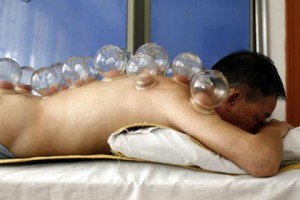 Cupping or 拔罐 (báguànr) is a type of Chinese massage that consists of attaching several hollowed-out glass “cups” to the body. These cups work to massage soft tissue, by pulling and stretching the skin. This occurs through a vacuuming process in which these cups literally adhere to the persons body, “sucking” skin up into the cups.
Cupping or 拔罐 (báguànr) is a type of Chinese massage that consists of attaching several hollowed-out glass “cups” to the body. These cups work to massage soft tissue, by pulling and stretching the skin. This occurs through a vacuuming process in which these cups literally adhere to the persons body, “sucking” skin up into the cups.
Cupping is a common massage therapy practice in Chinese traditional medicine, used to alleviate back pain, body soreness/pain, rheumatism and even the common cold. Here’s an example of how cupping is applied to a patient:
http://www.youtube.com/watch?v=NweGEgup74Q
Practice (作法)
When applying a cup, the air inside it is first heated (usually via a match), which burns off internal oxygen inside the cup. The cup is then quickly applied to the skin. The lack of oxygen inside the cup causes an imbalance of air pressure and forms an air-tight seal. This happens as the air inside the cup cools and contracts, forming a partial vacuum, enabling the cup to suck the skin, pulling in soft tissue, and drawing blood to that area and stimulating the healing process.
Cups are normally used only on softer tissue that can form a good seal with the edge of the cup. They may be used singly or in large quantities to cover a larger area. They may be used by themselves or placed over an acupuncture needle. Skin may be lubricated, allowing the cup to move across the skin slowly. The skin may be lanced before placing the cup so that the vacuum draws fluids, primarily blood, into the cup as part of the treatment
Depending on the specific treatment, skin marking is common after the cups are removed. This may be a simple red ring that disappears quickly, or more pronounced deeper bruising. In general, the longer a cup is left on, the more of a circular mark is created. Usually treatments are not painful, but treatment should be discontinued if the person receiving it experiences more than minor discomfort.
Follow Steve on Twitter: @seeitbelieveit


Comments:
SHASHIKANT GODBOLE:
A nice studied treatment.Helps knowledge.
SHASHIKANT GODBOLE